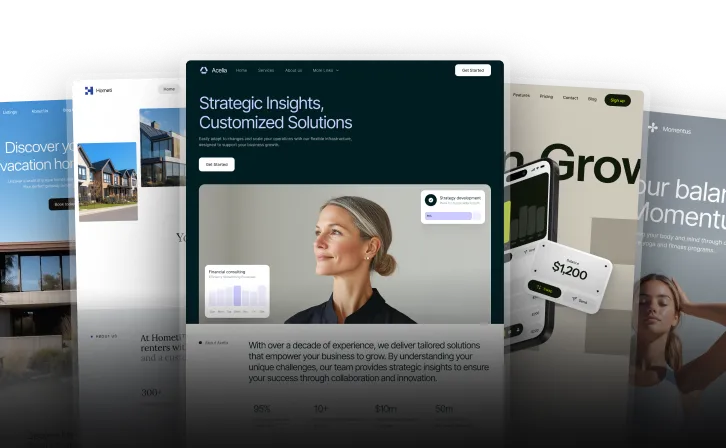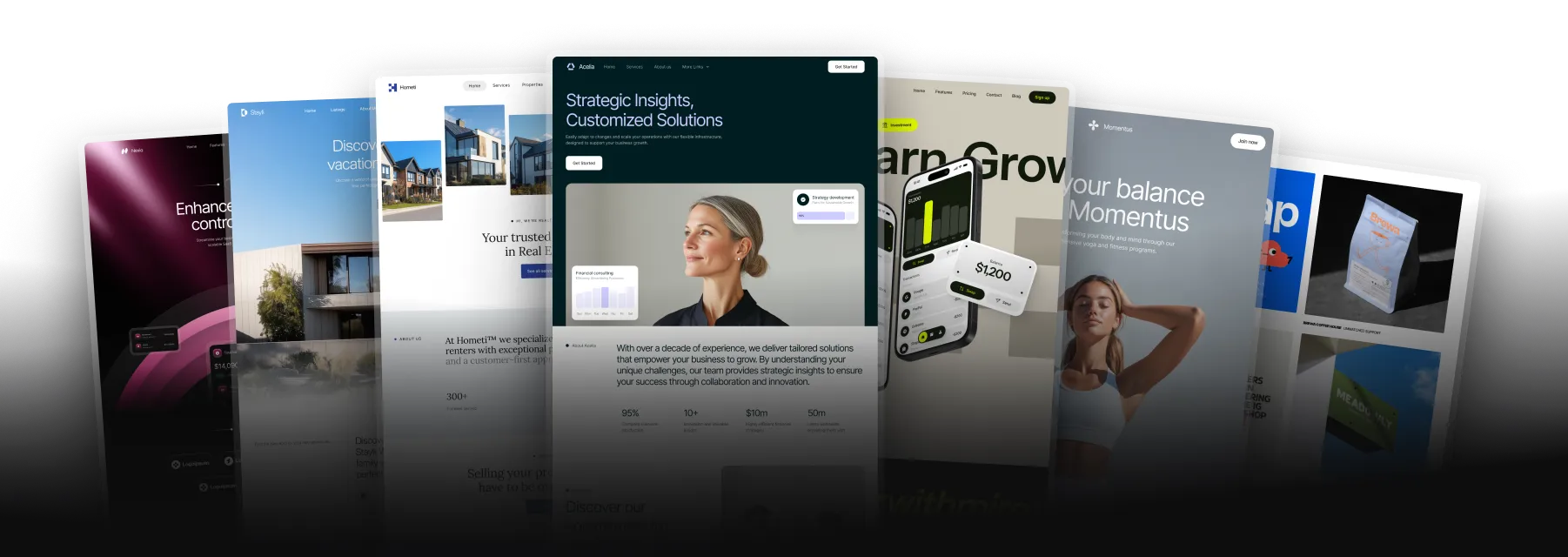Website Template SEO: Essential Optimization Tips
Unlock all templates




A visually appealing website template is only effective if it’s optimized for search engines. Here's how to make your site rank higher:
- Metadata: Write unique, keyword-rich titles (50–60 characters) and meta descriptions (under 155 characters). Use schema markup for rich search results.
- Headings: Structure content with proper H1 to H6 tags for clarity.
- Images: Optimize file names, alt text, and sizes to improve load speed and accessibility.
- Mobile Design: Ensure responsiveness and test across devices - 59% of global traffic is mobile.
- Page Speed: Compress code, reduce image sizes, and use caching/CDNs to load pages faster.
- Technical SEO: Set up robots.txt, sitemaps, and fix duplicate content issues.
Quick Tip: 91.5% of search traffic goes to Google’s first page. Prioritize these optimizations to turn your template into a high-performing website.
The Only Webflow SEO Checklist You Need to Watch

Setting Up Template Metadata
This section dives into practical strategies for metadata, focusing on how search engines interpret and organize your content.
Writing Title Tags and Meta Descriptions
Every page needs a unique, keyword-focused title (50–60 characters) to avoid being cut off in search results. A good structure for title tags looks like this:
Primary Keyword | Secondary Keyword | Brand Name
For example, instead of a generic title like "Home - My Business", aim for something like "Professional Web Design Templates | Custom Layouts | DesignPowers."
Meta descriptions should complement the title and stay within 155 characters. As Stephen Light, CMO of Nolah, puts it:
"Think of meta descriptions as a continuation of your brand and an opportunity to clearly define your USP using relevant keywords...They're little ads and, though the character length can feel constraining, are excellent short bursts of promo."
To take it a step further, use schema markup to enhance how your content appears in search results.
Adding Schema Markup
Schema markup allows search engines to display rich snippets, which can boost click-through rates. Google prefers the JSON-LD format, which you should add to your <head> section.
For product-focused templates, include details like:
- Product name
- Price
- Availability
- Reviews
- Brand information
To ensure your schema is correctly formatted, use Google's Rich Results Test tool.
After setting up schema, focus on creating clear and concise URLs to round out your SEO strategy.
Building Clear URLs
A clean URL structure improves both user experience and search engine ranking. Here's a quick guide:
| Do | Don't |
|---|---|
| Use HTTPS protocol | Add dates to blog URLs |
| Keep URLs short and descriptive | Use underscores or spaces |
| Include relevant keywords | Add unnecessary stop words |
| Use hyphens to separate words | Use special characters |
For example, a strong URL would look like this:
https://yoursite.com/blog/seo-template-guide
Avoid overly complex URLs like:
https://yoursite.com/blog/2025/03/06/the-complete-guide-to-seo-templates-and-optimization
If you update URLs, make sure to use 301 redirects to maintain SEO value and avoid broken links.
Content and Image Setup
Once your metadata is in place, organizing your content effectively improves both SEO performance and user navigation.
Heading Structure (H1-H6)
Headings act as a guide for search engines to understand your content. As John Mueller, Google Search Advocate, puts it:
"When it comes to text on a page, a heading is a really strong signal telling us this part of the page is about this topic… general signal that you give us that says… this part of the page is about this topic. And this other part of the page is maybe about a different topic."
Here’s a simple breakdown of heading levels and their purposes:
| Heading Level | Purpose | Example |
|---|---|---|
| H1 | Main page title (used only once) | Professional Web Design Services |
| H2 | Major sections | Our Design Process |
| H3 | Subsections | Initial Consultation |
| H4-H6 | Detailed breakdowns | Project Timeline Details |
With headings in place, the next step is optimizing your images to complement your content.
Image Text and Names
Properly optimized images not only enhance user experience but also send strong SEO signals. Here's how to do it:
File Names:
- Use descriptive, hyphenated names (e.g., "custom-wordpress-template.jpg").
- Keep names short yet meaningful.
- Naturally include relevant keywords.
Alt Text Structure:
- Write clear, contextual descriptions.
- Incorporate target keywords where appropriate.
- Limit text to 125 characters.
- Use empty alt attributes (alt="") for purely decorative images.
For functional images like icons or buttons, describe their purpose. For example, instead of "magnifying glass icon", use "search button" to clarify its function.
After optimizing your images, focus on building a strong internal link structure to establish content relationships.
Internal Link Structure
Internal links help define your site's hierarchy and guide users through related content. Yoast offers a great example with their keyword research setup:
-
Create Pillar Content
Their "The ultimate guide to keyword research" serves as the main hub for related articles. -
Build Topic Clusters
Supporting articles like "What is keyword research" and "Focus on long tail keywords" link back to the main guide while also linking to each other. -
Maintain Link Health
Regularly audit links to fix broken connections and address orphaned pages.
Tom Capper, Sr Search Scientist at Moz, highlights the importance of clear headings:
"From a direct ranking perspective, a clear heading on a page is an important signal of what a page is about."
Speed Optimization
Page speed is crucial - not just for user experience but also for better search rankings. Nearly half of users (47%) expect pages to load within 2 seconds. Here's how to ensure your site meets those expectations.
Code Compression
Streamlining your code is one of the easiest ways to improve load times. For example, JavaScript minification can reduce file sizes by up to 90%.
| Optimization Type | Purpose | Best For |
|---|---|---|
| Minification | Removes whitespace and comments | Basic optimization |
| Advanced Minification | Renames variables for smaller size | Deeper compression |
| GZIP Compression | Creates smaller binary files | Server-level optimization |
For WordPress sites, plugins like Autoptimize or W3 Total Cache can automate this process. If you're working with custom templates, tools like CSS Minifier offer quick solutions.
Once your code is optimized, the next focus should be on images - often the biggest culprit for slow loading.
Image Size Reduction
Images can be a major bottleneck, but optimizing them doesn’t have to be complicated. Here’s how:
-
Choose the right format:
- Photos: Use WebP or AVIF for smaller file sizes (30-50% smaller than older formats).
- Transparent graphics: PNG.
- Icons and logos: SVG.
- Complex photos: JPEG as a fallback.
- Optimize dimensions: For high-resolution screens, use images that are twice the container width (e.g., 1200px for a 600px display) to maintain clarity.
- Compress without quality loss: Tools like TinyPNG can shrink file sizes while keeping quality intact. Pair this with lazy loading to delay loading off-screen images, speeding up initial page loads.
After addressing images, caching is the next step for even faster load times.
Caching and CDN Setup
Caching and Content Delivery Networks (CDNs) are essential for reducing load times and keeping visitors engaged. Studies show that 40% of visitors will leave if a page takes over 3 seconds to load.
| Cache Type | Implementation | Benefit |
|---|---|---|
| Browser Cache | Set cache-control headers | Faster repeat visits |
| Server Cache | Use reverse proxies | Reduces server load |
| CDN Cache | Distribute content globally | Lowers latency |
Popular providers like Cloudflare and Amazon CloudFront offer tailored optimization options for different templates. To maintain freshness, use cache invalidation strategies.
For specific templates, consider these caching methods:
- Static pages: Full-page caching.
- Dynamic sections: Fragment caching.
- Template components: Component-level caching.
With caching in place, the final step is ensuring your site runs smoothly on mobile devices.
sbb-itb-fdf3c56
Mobile Setup
Speed and content optimization are crucial for mobile users. With mobile devices accounting for 59.16% of global traffic, your template needs to perform well on smaller screens. Plus, 74% of users revisit mobile-friendly sites, and 68% of mobile-first websites report increased sales.
Device Testing
Google PageSpeed Insights (PSI) is a powerful tool for analyzing mobile performance. It evaluates three key factors:
| Aspect | What It Measures | Why It Matters |
|---|---|---|
| Load Time | How quickly the page loads | Users tend to leave sites if they take longer than 2 seconds to load. |
| Responsiveness | Interaction with page elements | Affects how users engage with your site. |
| Visual Stability | Content shifting during loading | Impacts the quality of the visual experience. |
Combine PSI with tools like SE Ranking's Mobile-Friendly Site Test and Lighthouse to get a full picture of your template's mobile performance. Focus on Core Web Vitals, as these metrics directly impact search rankings.
Mobile Design Rules
To ensure your template works smoothly on mobile devices, follow these guidelines:
- Set clickable elements to at least 44px with 8px padding.
- Use a minimum font size of 16px for body text.
- Make sure all content scales properly on smaller screens.
Monitor user interactions, especially with pop-ups, to catch any usability problems. Replace auto-playing videos with static images to improve load times and create a better experience for mobile users. Once your design is optimized, apply mobile-first technical practices to maintain strong rankings.
Mobile-First Setup
Google primarily uses mobile versions for indexing and ranking. To meet mobile-first standards, implement these technical features:
| Requirement | Implementation | Purpose |
|---|---|---|
| Responsive Design | Use responsive HTML | Aligns with Google's preferred approach. |
| Content Parity | Match content across versions | Ensures consistent indexing and user experience. |
| Metadata Consistency | Keep tags identical on both versions | Preserves SEO value. |
| Structured Data | Include on the mobile version | Boosts search visibility. |
Optimize performance further by using a CDN and compressing images. Regularly test your site on various devices to catch and fix issues before they affect users.
Technical SEO Steps
Once you've optimized metadata and content, it's time to fine-tune how search engines interact with your template.
Robots.txt and Sitemap Setup
Your robots.txt file guides search engine crawlers, while an XML sitemap helps with indexing. Here's how to set them up on template platforms:
| Platform Feature | Implementation Steps | Purpose |
|---|---|---|
| Robots.txt Control | Go to Site settings > SEO > Indexing | Manage crawler access |
| Sitemap Generation | Check size limits (50MB/50,000 URLs) | Support search indexing |
| Staging Protection | Turn off "Staging indexing" | Block test site indexing |
Note: Google ignores <priority> and <changefreq> values in XML sitemaps, so focus on maintaining an accurate and updated URL list. Add your sitemap URL to your robots.txt file like this:
Sitemap: https://your-site.com/sitemap.xml
After setting this up, tackle duplicate content issues to strengthen your technical SEO.
Duplicate Content Prevention
Duplicate content can hurt your site's search rankings. Address this with the following steps:
- Canonical Tags: Different platforms handle these differently. For example, Webflow allows global settings, Wix adds self-referential canonical tags automatically, and WordPress uses SEO plugins for this purpose.
- URL Structure: Avoid duplicate URLs by disabling session IDs and setting up proper redirects for URL variations.
Once duplicate content is under control, focus on improving your site's appearance when shared on social media.
Social Media Tags
Boost engagement on social platforms by using the right meta tags. For instance, tweets with cards see a 43% higher engagement rate.
| Tag Type | Required Elements | Optimal Dimensions |
|---|---|---|
| Open Graph | og:title, og:description, og:image | 1200 x 630px |
| Twitter Cards | twitter:card, twitter:title, twitter:image | 800 x 418px |
| Site Name | og:site_name | N/A |
Keep titles between 40-60 characters and descriptions around 200 characters to avoid truncation. Use high-quality JPEG or PNG images with your branding to make them stand out.
Common Template SEO Problems
Even well-optimized templates can run into recurring SEO issues. Here's a breakdown of common challenges and practical solutions.
Basic Metadata Fixes
Metadata problems are a frequent issue with templates, often impacting search rankings. Here's how to address them:
| Issue | Solution | Impact |
|---|---|---|
| Missing Title Tags | Add unique titles within <head> |
Boosts visibility in search results |
| Duplicate Titles | Create distinct titles for each page | Avoids keyword cannibalization |
| Generic Meta Descriptions | Write unique 160-character summaries | Improves click-through rates |
| Empty Meta Tags | Fill in all metadata fields | Enhances relevance for searches |
According to Sitebulb:
"The title tag is considered one of the most important on-page SEO factors, so if it is missing this represents an issue that may affect search engine rankings and click-through-rate from the search results".
Image Loading Speed
Slow-loading images can frustrate users, especially since 83% of users expect pages to load in under three seconds. Oversized desktop images can consume 2x to 4x more data than necessary when viewed on mobile devices.
To improve image performance:
- Choose Better Formats: Switch to WebP for file sizes that are 25-34% smaller than JPEGs.
- Compress Images: Use lossless or lossy compression based on your needs.
- Optimize Delivery: Enable browser caching and use a CDN for quicker load times.
Mobile Display Issues
Templates often struggle with mobile optimization, leading to poor user experience on smaller screens. Here are some common problems and their fixes:
| Problem | Solution |
|---|---|
| Overlapping Elements | Adjust spacing and resize components |
| Unreadable Text | Use responsive fonts and shorter content blocks |
| Touch Targets Too Small | Increase button sizes for easier tapping |
| Viewport Issues | Add a meta viewport tag for proper scaling |
Dafna Rabin, Wix Templates design lead, emphasizes:
"I think it's important to check your website after you finish editing it. Publish it and check how it looks in the browser. Scroll through the site, check it on mobile devices and test it on different screen resolutions to ensure everything looks good and works properly".
For consistent mobile layouts, stick to HTML5 and CSS instead of Flash, and group related elements thoughtfully.
Next Steps
Quick Tips List
Here’s a handy list of tasks to focus on when optimizing your template:
| Priority | Task | Expected Impact | Complexity |
|---|---|---|---|
| High | Meta Title & Description Setup | Boosts visibility on search results | Low |
| High | Mobile Responsiveness Check | Improves mobile performance | Medium |
| Medium | Schema Markup Implementation | Adds rich snippet opportunities | High |
| Medium | Image Compression | Speeds up page loading times | Low |
| Low | Social Media Tags | Improves social sharing | Low |
Use these priorities as a roadmap for your initial setup.
Getting Started
Once you’ve identified your priorities, it’s time to dive into the details. Here’s how to get started:
Assessment Tools:
- Google PageSpeed Insights: Analyze performance, accessibility, best practices, and SEO metrics with Lighthouse data.
SEO Platforms:
- For Beginners: Mangools ($49/month) – A user-friendly tool to track metrics and diagnose issues.
- For Advanced Users: Semrush ($139.95/month) – Offers more robust features for advanced tracking and automated improvements.
Implementation Strategy:
-
Set up the technical foundation:
- Add your site to Google Search Console.
- Install Google Analytics for tracking.
-
Focus on content optimization:
- Structure headings (H1 to H6) properly.
- Write clear and engaging meta descriptions.
- Add schema markup to enhance search engine understanding.
-
Monitor and refine:
- Check your rankings weekly.
- Review Core Web Vitals monthly.
- Refresh and update your content every quarter.
For deeper audits and ongoing maintenance, consider tools like Screaming Frog SEO Spider ($259/year) or Surfer ($99/month). These can help you stay on top of technical and content-related improvements.
Related Blog Posts
Recommended posts
Unlock all templates







